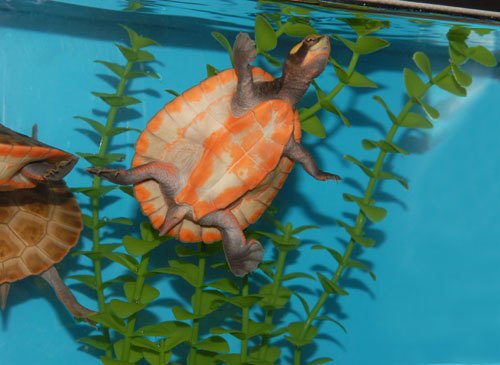Pink Belly Sideneck Turtles, scientifically known as Emydura subglobosa, are popular reptiles that are commonly kept as pets. These turtles, native to the freshwater regions of Australia, are known for their unique pink bellies and distinctive sideneck appearance. If you are considering adding a Pink Belly Sideneck Turtle to your collection, one of the essential factors to understand is their growth potential.

Credit: www.allturtles.com
Size and Growth Rate
Pink Belly Sideneck Turtles start their life as tiny hatchlings, measuring approximately 1.5 inches long. However, they will experience substantial growth throughout their lifetime. On average, these turtles reach a size of 6 to 7 inches when fully grown, with females being slightly larger than males.
The growth rate of Pink Belly Sideneck Turtles can vary based on several factors, including diet, habitat conditions, and individual genetics. Generally, these turtles grow at a rate of 1 to 2 inches per year during their first few years. However, it is important to note that growth rates may slow down as the turtles approach adult size.
Factors Affecting Growth
Various factors influence the growth rate of Pink Belly Sideneck Turtles. Proper care and attention to these aspects will contribute to ensuring healthy development:
- Diet: Providing a well-balanced diet is crucial for the growth and overall well-being of your Pink Belly Sideneck Turtle. Their diet typically includes a combination of commercial turtle pellets, live or frozen aquatic invertebrates, and vegetables. Offering a variety of foods ensures they receive all necessary nutrients.
- Habitat: An appropriate habitat is essential for proper growth. Pink Belly Sideneck Turtles require a spacious tank with enough swimming area, a basking platform, and proper lighting and heating. Maintaining suitable water quality and temperature is crucial to ensure optimal growth and health.
- Genetics: Individual turtles may have different growth potentials based on their genetics. While some Pink Belly Sideneck Turtles naturally grow faster, others may take more time to reach their adult size. Providing consistent care will help them achieve their maximum growth potential.
Maturity and Lifespan
Pink Belly Sideneck Turtles reach sexual maturity at around 4 to 5 years of age. It is at this point that they are fully grown in size and capable of reproducing. However, it’s important to note that turtles, just like any other living being, have individual variations, and maturity may slightly differ between individuals.
When adequately cared for, Pink Belly Sideneck Turtles can live for several decades. With proper nutrition, a suitable living environment, and regular veterinary check-ups, these turtles can enjoy a lifespan of 30 to 40 years or even longer.

Credit: reptilesmagazine.com
In Conclusion
Pink Belly Sideneck Turtles are captivating reptiles that can make fantastic pets. Understanding their growth potential is essential for providing them with the best care. These turtles grow to an average size of 6 to 7 inches and reach sexual maturity at around 4 to 5 years of age. By ensuring a balanced diet, proper habitat conditions, and consistent care, you can help your Pink Belly Sideneck Turtle reach its optimal growth potential and enjoy a long and healthy life by your side.





Leave a Reply